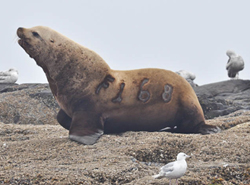
How does scientific marking and tagging affect marine mammals?For decades, field researchers have applied paints, dyes, brands and telemetry tags to wild animals to track their movements and behaviors in nature. But does tagging or marking a wild animal change its behavior over time? Do marked marine mammals experience pain or suffering that changes their normal behavior on land or in water? How can we know?  A female Steller sea lion branded as a pup at Forrester Island in Southeast Alaska These questions, framed in a new Consortium study published in the journal Wildlife Research, address important gaps in scientific understanding that could profoundly influence future field research. Animal welfare studies, such as this one, offer an important new dimension to the Consortium’s interdisciplinary field research program.  A female northern fur seal from St. Paul Island, Alaska, carrying biologging tags to collect data on where and how she obtains food There was a wide range in the studies looking at marking effects. Some studies measured whether placing a satellite transmitter on a seal affected swimming behaviors, while others studied the pain associated with the controversial practice of hot-iron branding on sea lions. Others measured the overall survival of a group of tagged animals within a population. “Our analysis identified the need for more species-specific studies to be conducted,” says Walker. “It may be problematic to generalize the results of studies between different species, such as elephant seals and bottlenose dolphins, because species may react differently to a particular device.” ETHICAL STANDARDS In the remote waters of the North Pacific Ocean, tagging and marking has played a critical role in helping scientists to identify and track endangered seals and sea lions. Consortium researchers have always approached this type of research with the highest ethical standards, says Science Director and study co-author Andrew Trites. “Working one-on-one with sea lions and fur seals at the Vancouver Aquarium has profoundly influenced the ways in which we study marine mammals,” says Trites. “We can’t conserve wildlife if we rely on techniques that alter natural behaviors and physiological responses, because this would generate unreliable scientific results. Conservation and the welfare of animals must go hand in hand.”
|

Kristen Walker makes behavioral observations of Steller sea lions at the Alaska SeaLife Center as part of her PhD research conducted under NMFS Permit #881-1890
The study conducted by Walker and colleagues describes eleven guidelines for minimizing the impact of marking on study animals, six of which are from previously published studies while five are new recommendations. The authors encourage researchers to publish all results of marking effects—especially studies that find a negative impact on the animals or the data, which often go unpublished. These studies provide important knowledge for adapting and refining approaches to marking and tagging.
BRIDGING THE GAP
As a Master of Science graduate student, Walker became concerned for the welfare of individual animals involved in field research. “I was working with sea otters who were being surgically implanted with radio-telemetry devices,” she says. “When I asked what would happen to the animals after surgery, little was known except that they typically survive—there was no mention of the pain associated with the surgery or how the surgery and tags might affect their long-term behavior. I was surprised to learn there was very little research conducted in this area. I decided to focus my future research efforts on trying to measure the impacts of marking devices to help reduce the possible suffering of tagged animals.”
Since then, Walker has tried to conduct research that can bridge the gap between animal welfare, which focuses on the individual animals, and conservation science, which focuses at the population level. “Combining these two disciplines allows for more attention to be placed on the individual animal, while still meeting overall conservation program goals,” she says.
Walker believes that a new movement to incorporate animal welfare practices into population-level studies is replacing an older mentality of sacrificing a few animals for the good of the many. She and other scientists are calling for increased funding for research in this area.
PUBLICATION:
|
|||||||||||||||




